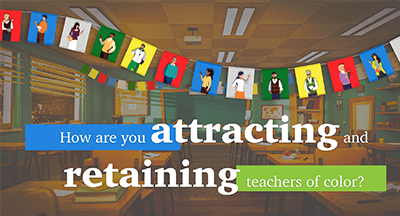
Are you a math person?
If one phrase can strike fear into the hearts of anxious students, it’s the term “math person.”
Because reading is the foundation of navigating life, there’s tons of emphasis placed on coaching and meeting students where they are. Math, not so much—or at least it’s easier to chalk up to someone just not being a “math person.” If you’re not a math person, you can still go on to do great things. Don’t worry about not being a math person. Everyone has a calculator in their pockets. Right?
Not so fast. Early evidence of math anxiety can get kids labeled—or tracked—into never being offered an opportunity to even get close to higher-level math concepts. Being relegated to a lower track of math education also happens disproportionately more often to students of color (you guessed it! And the research backs it up), girls, and low-income students. Culturally, not long ago a boy was more likely to encounter a positive math or science topic on a t-shirt, while girls' clothes bore messages about shopping, items, and interpersonal conflict (“sugar, spice, and everything nice” endures the test of time).

It's a thinking trap: A black-and-white, binary presentation of logic vs. emotion, math vs. reading. School subjects are presented as a set of false binary options when they should be equally encouraged. Humans love to group and sort and assign meaning to all kinds of things, pet subjects in school very much among them. But by giving credence to the myth of being a math person or not, we seed a self-fulfilling prophecy of math anxiety.
How many STEM stars have been passed over?
And how many are waiting in the wings?You’re a math person or not a math person.
And if you’re not a math person, can you be a STEM person?
An estimated shortage of 85 million tech workers is predicted within the next decade, and already a third of workers lack important tech skills needed to thrive. While these numbers are often cited amid worries about revenue, what about people? What about innovation and the future of work and our world? Are we preparing students to be confident contributors in charge of their own lives and destinies?
The good news: our collective awareness of the pitfalls of kids of color and girls in STEM has resulted in positive changes for current students.
Read more about the bright future one student stumbled upon in STEM
Math people aren’t real, but math differences are.
And they’ve been documented globally.
Where does math anxiety fit in? What about dyscalculia?
These are two distinct barriers students might experience in their math development.Math anxiety is the fear of poor performance in math that holds students back from taking the risks necessary to practice math.
Dyscalculia is a learning disability that prevents students from learning numeracy and math concepts at grade level alongside neurotypical peers.
Both impact student performance and require intervention, but with different strategies and supports.
Some people aren’t math people, sure. The question is, who among them might moonlight as a math person, with the proper accommodation including motivation and maybe a tiny bit of encouragement?
People who experience dyscalculia make up between three and seven percent of our population and are disproportionately underdiagnosed.
As for math anxiety, well. A disconnect between the perceived value of math and science as well as students’ level of worry work harder against girls than their boy peers. See the following excerpt from a study of peer academic reputations (PAR) in math and science during early adolescence.
“Our findings are in line with prior research that has shown that while early adolescent girls earn higher grades in math and science class than their male peers (Robinson & Lubienski, 2011), they do not tend to have higher perceptions of ability or value for these subjects (Leaper, 2015). Interestingly, in our sample, girls reported higher levels of worry in math and science compared with boys by the end of the year. This pattern may be due to differences in how girls and boys approach achievement situations (Leaper, 2015). Pomerantz, Altermatt, and Saxon (2002) noted two ways in which girls and boys engage in school differently. First, girls tend to be more concerned with pleasing others which can heighten their effort in school but leave them vulnerable to anxiety over whether they are disappointing others. Second, girls are more sensitive to feedback than boys. Girls tend to view feedback as diagnostic of their ability whereas boys tend to adopt a confident approach and deny the informational value of feedback. Both girls’ wanting to please others and their attunement to feedback may increase effort and achievement, but at the same time leave them vulnerable to anxiety (Pomerantz et al., 2002). Our findings support this conceptualization.”
—Excerpt from North, Elizabeth A. and Allison M. Ryan, “The Association of Peer Academic Reputations in Math and Science with Achievement Beliefs and Behaviors During Early Adolescence,” The Journal of Early Adolescence. Vol. 38, Issue 6. June 2018. pp. 772-794. Access the research.
Does placing students on math tracks limit their agency?
Answering a few questions might help ensure it doesn’t.Self-selecting out vs. being tracked out
Student agency is, by definition, decided by individual students. The paths students place themselves on matter. The paths educators place students on muddy the waters of student agency. This is NEVER to say that educators aren’t acting with a professional concern for students. It’s simply another opportunity to confront personal covert biases that may influence how students’ math trajectory is plotted.Questions to ask about whether math tracking limits student agency:
- Are students aware of the different math paths?
- Do students realize their math performance in early education impacts their opportunities in later education?
- Is math anxiety a factor in the student’s performance?
- Have students who are slated for lower-level math tracking been screened for dyscalculia?
How can district leaders help?
Always start with the one in the mirror: examining your own covert biases is eye-opening. There are tools you may decide to use district-wide to encourage everyone to confront cognitive bias, or you can explore your preconceived notions using tools like this Implicit Association Test from Harvard.Nurture strong roots in early literacy and numeracy. The building blocks of math skills begin as early as reading skills and can be broken down into basic concepts instead of overwhelming students. For that matter, play-based learning isn’t limited to storytelling. Pretend play is just as effective when counting, noticing patterns, and solving problems.

Acknowledge that emotions and adverse experiences feed into the messages kids give themselves and the messages they pick up from adults. Adults need to challenge stereotypes, biases, and their own experiences on behalf of students.
Finally, opportunities must be open to all students. Students must have the chance to try and fail rather than never having tried at all. At the very least, it means students who struggle in math in the early years cannot be written off without investigating underlying difficulties.
STEM jobs have a culture issue.
Finally, among those 85 million vacancies in STEM careers, it would be disingenuous to not mention new research shows a “leaky pipeline” of STEM workers dropping out of STEM professions after graduation. The culprit? An unrelenting culture of demanding workweeks and management expectations masked behind tempting employee amenities, which often turn out to be myths.Educators cannot fix the cultures of corporate America—only people can do that. Educators can contribute by graduating crews of divergent thinking STEM students who didn’t start out that way, and who bring a different set of viewpoints to the workplace.
Because everyone is a math person—some just don’t know it yet.
WHAT'S NEXT FOR YOUR EDTECH? The right combo of tools & support retains staff and serves students better. We'd love to help. Visit skyward.com/get-started to learn more.

|
Erin Werra Blogger, Researcher, and Edvocate |
Erin Werra is a content writer and strategist at Skyward’s Advancing K12 blog. Her writing about K12 edtech, data, security, social-emotional learning, and leadership has appeared in THE Journal, District Administration, eSchool News, and more. She enjoys puzzling over details to make K12 edtech info accessible for all. Outside of edtech, she’s waxing poetic about motherhood, personality traits, and self-growth.


.jpg)


